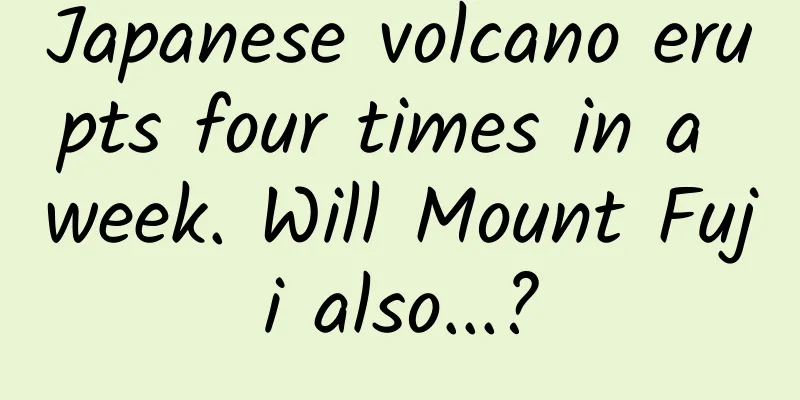Japanese volcano erupts four times in a week. Will Mount Fuji also...?

|
While the world's attention was still focused on earthquake relief efforts in Turkey and Syria, as well as the strong earthquake in Tajikistan, Japan, far away in East Asia, also sounded the alarm. From February 8, the Sakurajima Showa crater in Kagoshima Prefecture, Kyushu, Japan, has been erupting continuously, and the Sakurajima Minami-dake volcano, not far from the Showa volcano, has also begun to erupt on a small scale. In addition, three eruptions were observed at the Ontake crater on Suwanosejima Island in Kagoshima Prefecture, and Mount Aso in Kumamoto Prefecture in Kyushu also experienced relatively large volcanic micro-motions. For a time, the Kyushu region of Japan was shrouded in volcanic smoke. Distribution map of volcanoes in Kyushu, Japan. Based on PIE-Engine Studio The Japan Meteorological Agency still classified Sakurajima's volcanic alert level as Level 3, reminding the public to pay attention to volcanic rocks and pyroclastic flows within a 2-kilometer radius of the crater. Level 3 prohibits mountaineering activities, but has little impact on daily life. Image source: Japan Meteorological Agency Volcanic eruptions are not uncommon in Japan, which is located on the Pacific Ring of Fire, the largest and most active volcanic belt on the earth's surface. However, the intensive and simultaneous eruption of multiple craters has once again made the Japanese people and experts deeply worried about the big boss of volcanoes, Mount Fuji. Mount Fuji, which is predicted to erupt every year, symbolizes beauty and purity, disaster and destruction. 01 Why do gods show their power? In the days when humans did not understand nature, volcanoes were considered the abode of gods. When Mount Etna in ancient Sicily erupted, people said it was the wrath of the god of fire. Today, after scientific research, erupting volcanoes are more of an external manifestation of the planet's internal vitality. Mount Etna, the largest active volcano in Europe, spews enough lava every year to fill a 108-story skyscraper. Volcanoes are generally divided into "active volcanoes", "dead volcanoes" and "dormant volcanoes", but there is no generally accepted boundary between the three categories. Some volcanoes have only erupted a dozen times in thousands of years. They are active on a global scale, but not active on a human life cycle. There are more than 200 volcanoes in Japan, of which more than 80 are active volcanoes arranged in a regular pattern in the shape of a human figure on the Japanese archipelago. According to the theory of plate tectonics, the surface of the earth can be divided into several plates of different shapes and sizes. All plates are moving, causing collisions, compression or separation between the plates. Therefore, the boundaries of the plates are the most unstable areas, and Japan happens to be in such an unstable area. The Eurasian Plate, Pacific Plate, North American Plate and Philippine Sea Plate interact here, causing frequent earthquakes, tsunamis and volcanic eruptions. Based on PIE-Engine Studio As the highest mountain in Japan by the sea, the first thing you see when you arrive in Japan, whether by sea or air, is the upright, sky-high Mt. Fuji. Over the past 100,000 years, 500 cubic kilometers of magma have accumulated on both sides of Mt. Fuji, forming the holy conical mountain in harmony. The last major eruption of Mount Fuji occurred in 1707, during the reign of Emperor Kangxi of the Qing Dynasty in China. Thick smoke rose to 3,000 meters from the crater, reaching the stratosphere, and 4 centimeters of volcanic ash accumulated in Tokyo, 100 kilometers away. The eruption was also accompanied by the 8.6-magnitude Ho-ei earthquake. The last eruption also formed a new parasitic volcano, Mount Hoei, southeast of Mount Fuji. Image source: PIE-Engine Server Although the Japanese people have long learned to coexist with volcanoes, the eruption of Sakurajima is no stranger to them, and Aso Volcano even gave birth to the mascot Kumamon, the curse that "Mount Fuji may erupt again at any time" has always made Japan full of an inescapable sense of doomsday. The blush on Kumamon's cheeks is not only cute, but also reflects the title of Kumamoto Prefecture, the "Land of Fire", and represents the volcanic landform characteristics of Kumamoto Prefecture. 02 Neighboring a volcano Opening the map of Japan, the only way to describe it is "God's abandoned child". In terms of space, with volcanoes, earthquake belts, many mountains and no resources, it is undoubtedly the most disaster-prone place on earth; in terms of time, when it became the most developed empire in Asia after the Meiji Restoration, it was the last empire on earth. About 100 kilometers east of Mount Fuji is the heart of Japan, the Tokyo metropolitan area. The population density here can reach thousands or tens of thousands per square kilometer, and more than 80% of Japan's financial, educational, information and research and development institutions are also distributed. Tokyo is one of the few capitals in the world that is so close to a large volcano. Once the volcano erupts, it will inevitably be buried in volcanic ash. The Tokyo metropolitan area is trembling on the edge of Tokyo Bay. The entire coast of Tokyo Bay is completely expanded and connected urban land. Mapping based on PIE-Engine Server In recent years, scientists have detected rumbling sounds coming from deep within Mount Fuji - lava bubbling. If this is a precursor to an eruption, Tokyo will be hard to travel. If it happens to erupt in summer, the lives of tens of millions of tourists scattered on the flanks of the volcano, including golf courses, amusement parks and summer hotels, will be threatened. If an eruption occurs, it may take only 2 hours for lava to flow to the Tomei and Shin-Tomei Expressways connecting the east and west. Image source: Mount Fuji Disaster Prevention Council. The origin of Mount Fuji becoming a symbol of Japanese culture can be traced back to the Heian period. Before that, people's feelings towards Mount Fuji mostly remained at the level of appreciation and awe for nature. Later, Mount Fuji was deified as "the God of Fire, Sengen Okami", and Sengen Shrines dedicated to the God of Fire were spread all over Japan. The worship of Mount Fuji, which was born out of Japanese folk beliefs, also broke through the geographical scope around Mount Fuji. Japan's Arakurayama Sengen Shrine and Mount Fuji are in the distance. Image copyright of the gallery, no permission to reprint Since then, countless scholars have competed to sing praises of Mount Fuji. Yamabe Akato, a court poet in the early Nara period and one of the 36 poets, praised it as "a towering and beautiful peak, with endless interest wherever you look." The faith of a nation emerged in that place very close to the sky. To this day, there are many believers and followers, and the procession of worshippers is still a summer scene of Mount Fuji. The best of the "Thirty-six Views of Mount Fuji" by Ukiyoe artist Hokusai Katsushika is "A Clear Day with a Wind": the top of Mount Fuji is covered with broken silver and snow gullies. Image source: Wikipedia So, this is probably why, although Mount Fuji is not the most dangerous volcano in Japan, it is always at the center of eruption rumors when other volcanoes show some activity. However, with the current level of scientific research, humans are still unable to accurately predict the periodicity of volcanic eruptions. It is understandable that if we want to survive under the control of the powerful nature, we must remain extremely cautious. References: [1] Sun Lizhou. About 500 million people live near active volcanoes. Volcanoes trigger "doomsday imagination" [J]. Environment and Life, 2012, 12: 18-23. [2] Su Dechen & Sun Aiping. Energy release shocks the world, passion turns into mountains like fire - how much do you know about volcanoes [J]. Earth, 2022, 03: 6-12. [3] Hou Fanghui, Qin Ke, Lu Kai, et al. Structural and sedimentary characteristics and the onset of subduction in the middle section of the Kyushu-Palau ridge and basins on both sides: a comprehensive study of multi-channel reflection seismic data[J]. Marine Geology and Quaternary Geology, 2022, 42(5): 187-198. [4] Wang Haibo. Study on the deep tectonic background of intraplate large earthquakes: Comparison of four typical tectonic zones[D]. Nanjing University, 2021. [5] Wang Minzhao. Mount Fuji: The Construction and Dissemination of Japanese Cultural Symbols[A]. Journal of the Central Academy of Socialism, 2022, 01(2): 161-171. [6] Wang Ying & Wang Minjing. Examples of volcanic landforms[J]. Marine Geology and Quaternary Geology, 2018, 38(4): 3-19. [7] https://zhuanlan.zhihu.com/p/532437865 Source: PIE-Engine Earth Science Exploration The cover image and some images in this article are from the copyright library Reproduction of image content is not authorized |
<<: The cherry blossoms are in bloom. I wonder if there are any birds coming to eat the nectar?
Recommend
How to write the copy for Double Eleven? The heart is here!
The annual grand festival is coming I guess every...
Mobvoi launches the "Mobvoi App Store", Android Wear is gaining popularity
On January 25, 2016, Mobvoi held the first "...
Staying up late because of the epidemic? You will regret it someday!
With the frequent outbreaks of the epidemic, have...
Datong Mini Program Production Company, how much does it cost to make a wine utensils mini program?
The launch of mini programs has brought convenien...
【Liu Heng Ma Yi Shen Xiang】 Teacher Liu Heng explains the twelve palaces of face reading in "Ma Yi Shen Xiang" and how to recognize people by their faces
【Liu Heng Ma Yi Shen Xiang】 Teacher Liu Heng expl...
The brand extension crisis of Microsoft, Xiaomi and LeTV
[[141229]] Microsoft, the world's largest sof...
Internet TV enters dormant period, and needs to be alert to three major misunderstandings
In 2014, the endless emergence of products, const...
Google reveals more about integrating Rust into Android
Since 2019, the Android team has been working on ...
How to write Double Eleven copy to encourage users to place orders?
When it comes to copywriting , the first thing pe...
How to achieve user growth from the perspective of user retention goals?
Retention is the goal of many product operations ...
4K TVs are growing against the trend: So the question is, is it just hype or common sense?
What exactly is a 4K TV? In a nutshell, a 4K TV i...
How to quantify and analyze the effectiveness of operational activities
I believe that for many analysts who are just sta...
General Bradley's 2021 Trading Strategy Lecture
General Bradley's 2021 Trading Strategy Lectur...
How much does it cost to outsource Baidu keyword ranking optimization?
According to the Jimifeng website optimization ch...
Why do I always vomit after surgery? Exploring the risk factors and solutions for postoperative nausea and vomiting
▌The theme of this popular science creation comes...









